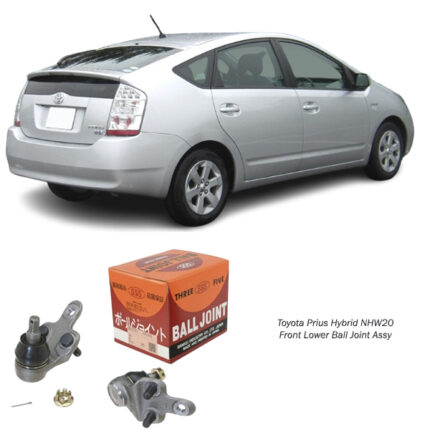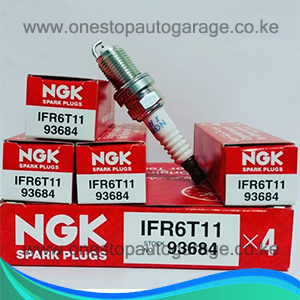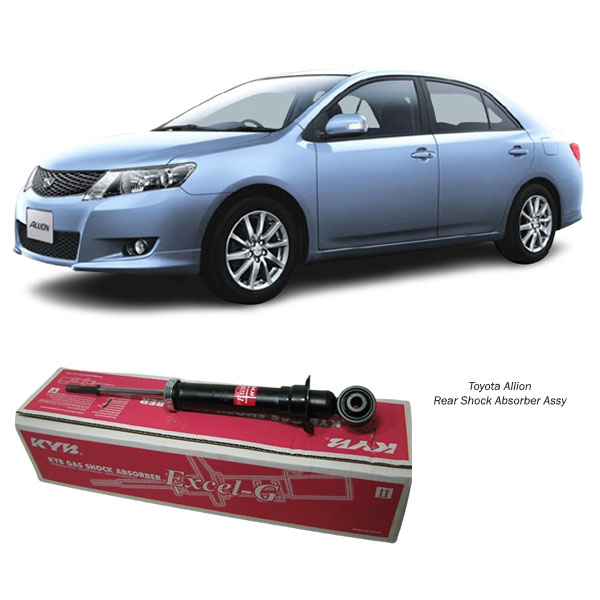-6%
Get Toyota Allion Rear Shock Absorber Assy 341336 in Kenya
The rear shock absorber assembly is a crucial part of your vehicle’s suspension system. Whether you drive a Toyota Prado 120/150, Nissan Note, Wingroad, Tiida, or any other vehicle, your rear shocks play a significant role in stability, comfort, and handling.
A worn-out or damaged shock absorber can cause poor ride quality, unstable handling, and increased braking distance. In this guide, we will explore the purpose of rear shock absorbers, their function, types, signs of failure, maintenance tips, and how to replace them.
What Is a Rear Shock Absorber Assembly? 🤔
A rear shock absorber assembly is a hydraulic or gas-filled suspension component that controls the movement of the rear wheels. It absorbs impact from road bumps, potholes, and uneven surfaces, ensuring that the tires maintain proper contact with the road.
Main Functions of Rear Shock Absorbers:
🔹 Dampen Road Bumps – Prevents excessive bouncing when driving.
🔹 Improve Ride Comfort – Reduces vibrations and harshness.
🔹 Enhance Vehicle Stability – Helps keep the car steady in corners.
🔹 Support Braking Efficiency – Reduces nose-diving under braking.
🔹 Increase Tire Lifespan – Ensures even wear by keeping tires in contact with the road.
Without properly functioning rear shocks, your vehicle will feel unstable, bouncy, and difficult to control, especially at high speeds or on rough terrain.
How Do Rear Shock Absorbers Work? ⚙️
Rear shock absorbers convert kinetic energy (motion) into heat energy, which is then dissipated through hydraulic fluid or gas. This process controls suspension movement and keeps the vehicle stable.
Working Principle:
1️⃣ When the Wheel Hits a Bump – The shock absorber compresses to absorb the impact.
2️⃣ Hydraulic Fluid or Gas Inside the Shock Absorber Moves – Restricting the movement to reduce bouncing.
3️⃣ The Shock Absorber Expands Again – Returning the suspension to its normal position.
4️⃣ Repeats Continuously – Ensuring a smooth ride by controlling up-and-down motion.
A worn-out shock absorber fails to control this motion, leading to excessive bouncing and poor handling.
Why Are Rear Shock Absorbers Important? 🚘
Your vehicle’s rear shock absorbers play a critical role in maintaining:
✔️ Ride Comfort – Without shocks, every bump would be felt harshly.
✔️ Handling & Control – Keeps your car stable during turns and braking.
✔️ Braking Efficiency – Prevents excessive forward weight transfer.
✔️ Suspension Longevity – Protects other suspension components from excessive wear.
✔️ Passenger Safety – Ensures the vehicle responds predictably to road conditions.
A worn-out rear shock absorber can make your car difficult to control, especially during emergency braking or high-speed maneuvers.
Signs of a Failing Rear Shock Absorber 🚨
Shock absorbers wear out gradually, so you may not notice an immediate change. However, here are the most common warning signs that indicate it’s time for a replacement:
🛑 Excessive Bouncing – The car bounces several times after hitting a bump.
🚗 Unstable Handling – The rear feels loose or sways during turns.
💨 Increased Braking Distance – The car takes longer to stop.
🔴 Leaking Fluid – Visible oil leaks from the shock absorber.
🌀 Uneven Tire Wear – Patchy tire wear caused by poor shock absorption.
🔧 Clunking or Knocking Sounds – Noises from the rear suspension over bumps.
If you notice any of these symptoms, replacing the rear shock absorbers is essential for safety and performance.
Common Causes of Rear Shock Absorber Failure ❌
Several factors can cause rear shock absorbers to wear out faster than expected:
🔹 Rough Roads & Potholes – Excessive impact accelerates wear.
🔹 Heavy Loads & Towing – Extra weight puts strain on shocks.
🔹 Corrosion & Rust – Weakens the shock body and seals.
🔹 Fluid Leaks – Loss of hydraulic fluid reduces effectiveness.
🔹 Age & Mileage – Shocks typically last 80,000 – 150,000 km before replacement.
If you frequently drive on rough roads or carry heavy loads, your rear shocks may need earlier replacement.
Types of Rear Shock Absorbers 🛠️
There are different types of rear shock absorbers, each offering unique benefits:
1️⃣ Hydraulic (Oil-Filled) Shocks
✔️ Common in most vehicles
✔️ Affordable & reliable
✔️ Can wear out faster than gas shocks
2️⃣ Gas-Charged Shocks
✔️ Improved performance & durability
✔️ More resistant to fading
✔️ Better handling on rough terrain
3️⃣ Coil-Over Shocks
✔️ Used in performance & off-road vehicles
✔️ Integrated coil spring for added support
✔️ Adjustable ride height & stiffness
For Toyota Prado 120/150, Nissan Note, Wingroad, and Tiida, gas-charged shocks are a great choice for comfort and durability.
How to Replace Rear Shock Absorbers – Step-by-Step Guide 🔧
Replacing rear shocks is a moderate-difficulty task that requires basic mechanical knowledge.
Tools & Materials Needed:
✔️ New rear shock absorber assembly (OEM or aftermarket)
✔️ Jack & jack stands
✔️ Wrenches & sockets
✔️ Penetrating oil (for rusted bolts)
✔️ Torque wrench
Replacement Process:
1️⃣ Lift the Rear of the Vehicle – Secure it with jack stands.
2️⃣ Remove the Rear Wheels – For easy access to the shocks.
3️⃣ Locate the Shock Absorbers – Found near the rear suspension arms.
4️⃣ Unbolt & Remove the Old Shocks – Use penetrating oil if bolts are rusted.
5️⃣ Install the New Shock Absorbers – Align and secure with bolts.
6️⃣ Torque the Bolts Properly – Follow manufacturer specifications.
7️⃣ Reinstall the Wheels & Lower the Car – Ensure everything is secure.
8️⃣ Test Drive – Check for improved ride quality and handling.
💡 Tip: If replacing one shock absorber, it’s best to replace both on the same axle for balanced performance.
OEM vs Aftermarket Rear Shock Absorbers 🏁
When choosing a replacement rear shock absorber, you have two options:
🔹 OEM (Original Equipment Manufacturer):
✔️ Designed for perfect fitment
✔️ High-quality materials
✔️ Longer lifespan but more expensive
🔹 Aftermarket Shock Absorbers:
✔️ Wide variety of choices
✔️ Can be performance-oriented (off-road, sports)
✔️ Some may not fit as precisely as OEM
For Toyota Prado 120/150, Nissan Note, Wingroad, and Tiida, OEM shocks provide the best ride quality and durability.
Maintenance Tips for Long-Lasting Rear Shock Absorbers 🏎️
To extend the lifespan of your rear shock absorbers, follow these tips:
✅ Inspect Shocks Every 10,000 km – Look for leaks or damage.
✅ Avoid Overloading the Vehicle – Reduces excessive strain.
✅ Drive Carefully on Rough Roads – Minimize shock wear.
✅ Replace Both Rear Shocks Together – Ensures balanced handling.
✅ Check for Suspension Noises – Catch early signs of failure.
Proper maintenance ensures smooth handling, comfort, and safety.
Final Thoughts 💭
The rear shock absorber assembly is essential for ride comfort, handling, and overall vehicle stability. Keeping it in good condition ensures a safe and smooth driving experience.
Follow us on Facebook for more parts.



